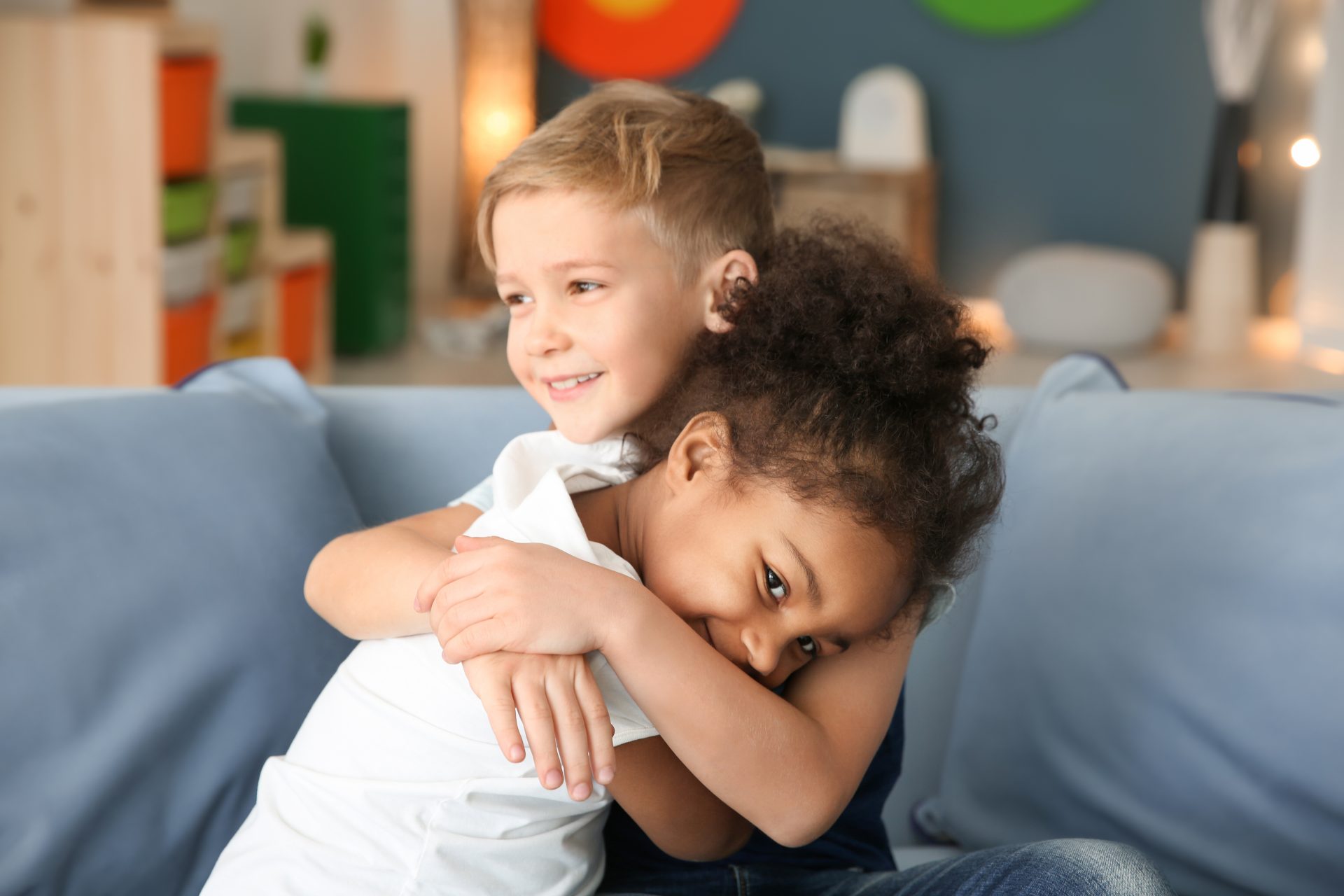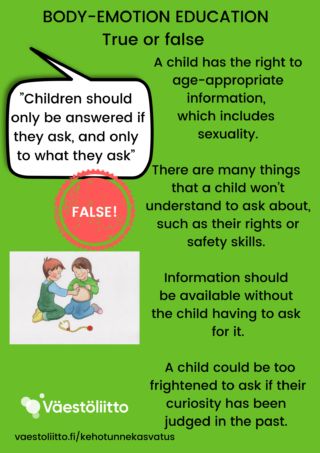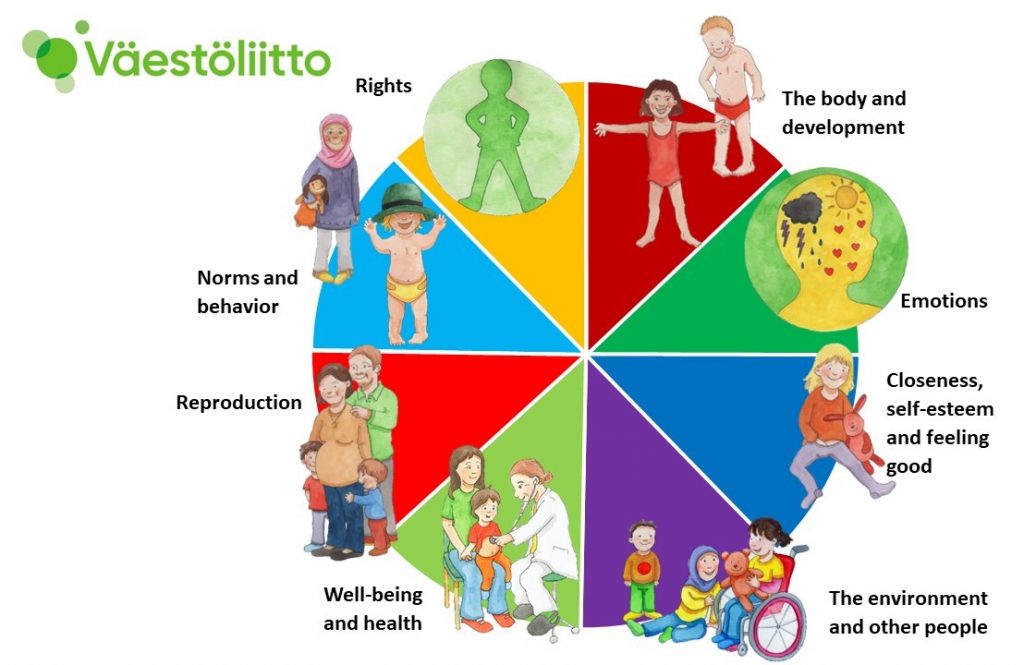Body-emotion education

– What is body-emotion education for young children?
– What does childhood sexuality mean?
– How do I make sure my answers to questions are age appropriate?
– How can children learn to respect their own body and the bodies of others?
– At what age can we start talking about safety skills?
– How do I support parents and encourage them to provide body-emotion education?
– How do I bring up these issues?
There are a lot of prejudices and misinformation about this unspoken topic. Children’s age-appropriate sexuality and sexuality education are taboo. Body-emotion education is well-being and health education that has been made to increase healthy growth and safety of children. See the cards about prejudices and answers to them here:
Ignorance, Only if a child asks, Already too much knowledge, Increases risks, Let kids be kids, Innocence breaks, Sexuality begins later, Too personal matter, Knowledge pushes to adulthood.

Materials in English are available here.
Read an interesting interview: Tania Mendes from UNESCO’s Global Partnership Forum on CSE interviewed Raisa Cacciatore and Henriikka Kangaskoski of Body-Emotion education. “Understanding why: CSE from kindergarten, research and the difficulty with naming genitals” about the place of comprehensive sexuality education for younger learners and how it’s been supported, challenged and the positive impact in Finland. An insightful and fun read with plenty of resources and extra links too. Sharing the knowledge.
Check out videos and lectures on body-emotion education in English.
Body-emotion education is equal to comprehensive, age-appropriate sexuality and safety skills education for children between the ages of 0 and 8. It covers a wide range of topics. It includes the child’s level of knowledge, skills, and positive attitude about the body, emotions, diversity, and rights. It aims at the well-being of the child. Our guidelines are based on studies, international recommendations and instructions issued by the Finnish National Agency for Education.
In the context of young children, the term used is body-emotion education rather than sexuality education. It is a specific term for describing the development and needs of children. When referring to young children’s age-specific sexuality, we use child-friendly words (see the article). Parents feel that the word ‘sexual’ was not suitable, for children are natural, innocent, playful and learners without any shame. We need to find a common language for parents and professionals so that they are comfortable using the words.

The WHO Standards for sexuality education in Europe (2010) covers eight sexuality education topics: (1) the human body and human development; (2) emotions; (3) sexuality; (4) relationships and lifestyles; (5) sexuality, health, and well-being; (6) fertility and reproduction; (7) social and cultural determinants of sexuality (values/norms); (8) sexuality and rights.
We created this pattern to describe the comprehensiveness of body-emotion education in terms of childhood sexuality.
Sexual development and children
The sexual development of a person from a young child through puberty into adulthood is a journey with many stages. The child’s body, understanding and emotions develop side by side. The events along this journey determine the person’s relationship with their body, sexuality, human relationship and ability to enjoy sexuality in adulthood.
The sexuality of young children is different from that of adolescents or adults. In children, sexuality can manifest, for example, in exploring and comparing the human body and its different functions. At the same time, children learn more about pleasure and good manners.
Important aspects for all children to learn and to discuss are for example:
- I can respect own and other people’s bodies, uniqueness, and diversity.
- I know I can ask and tell anything to trusted adults.
- I have the words to ask and talk also about genitals.
- I know my rights! I am equal with all others.
- I know that my body is good all over.
- I know how to protect my own body.
Digital safety skills
Our publications make it easy to start talking safety skills and digital safety skills for even the youngest children. They positively emphasize the first skills that any adult can teach a child. They provide good ground for children and young people.
The most important thing is to start talking early about respecting own and others’ bodies and rights and skills related to body as safety skills in a positive way. Children and adolescents protect the things that they value. Child must know the relevant names of genitals and find it accepted to speak about them openly. Only what can be talked about can also be protected. An open atmosphere to discuss with adults is built as a child. A youngster often does not want to talk to parent if the topic has already been made taboo. We must stop passing shame on to future generations, and talk about privacy and rights positively, through body-pride and respect.
Adults should tell that they know how to help in matters related to safety and digital safety, and they do not punish (such as take phone away) if the child has a problem. Adults are on the same side with children and protect them also when there are sexuality-related problems. This message is possible only, if adults first start open conversation positively about the value and rights related to the body.
All adults can and must do things to ensure children’s safety in their own environments, such as early childhood education, school, at home, hobbies and digital devices. It’s not just a technical issue but a question of communication, openness and self-esteem. Adults close to children must find the courage and words to talk to children about safety. “There are people who can’t or don’t want to follow the jointly agreed rules.” “Someone can trick you online, pretend to be someone else than they are.” “It’s not ok if someone sends you a nude picture without permission or takes a picture of you.” At the same time positive value on the body must be underlined: the right to be safe, because you are valuable and all places in the body are as valuable.
Find the digital safety skills poster here.
Guiding documents:
Guidelines issued by the Finnish National Agency on early childhood education, preschool and primary education are binding. They provide a good foundation for the implementation of body-emotion education. In March 2022 National Affairs of Education published the universal, mandatory National core curriculum for early education and care, which directs to ensure children’s rights, safety, safety skills, media skills and sexuality education. See more here.
In 2010, the WHO (World Health Organization) published a framework titled The Standards for Sexuality Education in Europe. The document provides authorities and experts with guidelines on the contents of sexuality education aimed at 0–18-year-olds.
Body-emotion education involving young children is always carried out together with the family.
The book ‘Non-Violent Childhoods – Action Plan for the Prevention of Violence against Children 2020–2025’, Ministry of Social Affairs and Health 2020:34 contains pp.. 176-190, chapter 7.4. ‘Safe body-emotion education and sexuality education’.
The Ministry of Social Affairs and Health appointed a working group to formulate Finland’s first Action Plan for the Lanzarote Convention (Finnish Treaty Series 87-88/2011) to prevent sexual violence against children and young people aged 0–17. The formulation of the Action Plan is included in the Programme of Prime Minister Sanna Marin’s Government. The Action Plan takes account of other ongoing national work relevant to the matter, such as the Action Plan for the Prevention of Violence against Children, entitled Non-Violent Childhoods, and the implementation of the Istanbul Convention.
Illustrations on the body-emotion education website: Minna Kähkönen